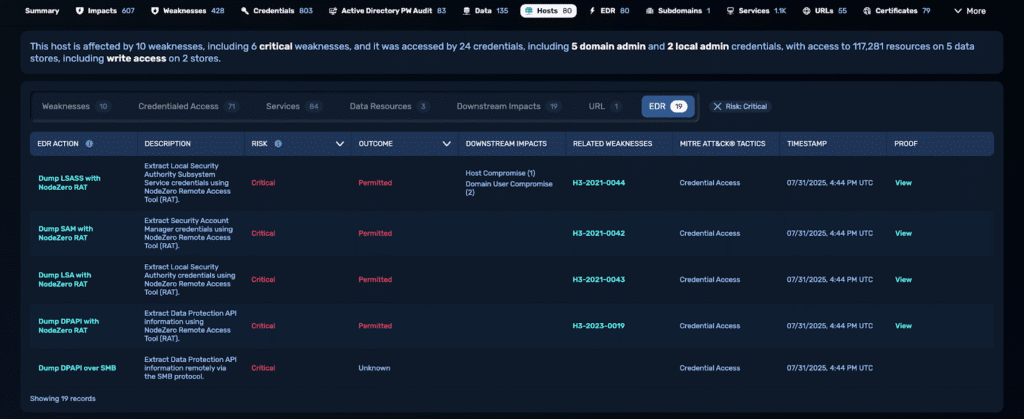EDR and XDR platforms are positioned as the backbone of endpoint protection. They promise to detect, block, and contain threats before attackers can gain a foothold. Yet many organizations are left asking the same questions: Where is our EDR deployed? Is it configured properly? Could something be slipping through?
The uncomfortable truth is that most enterprises don’t actually know how effective their endpoint security really is. They rely on deployment coverage reports, vendor dashboards, or occasional red team exercises — none of which reveal how well defenses hold up against real-world attack behavior. That gap between assumed protection and proven protection is what attackers exploit.
Organizations need a way to test endpoint security effectiveness safely in production, measure how EDR/XDR tools respond to adversarial techniques, and use that data to strengthen defenses.
Why Endpoint Security Validation Matters
EDR vendors provide extensive detection and reporting, but they only tell you what they see — not what they might be missing. Traditional validation methods like breach and attack simulation (BAS) or manual red/purple teaming provide point-in-time snapshots but fail to deliver continuous assurance.
Without validation, teams risk falling into a false sense of security. Blind spots remain hidden. Misconfigurations go unnoticed. And attackers exploit techniques such as credential theft, lateral movement, or privilege escalation that may bypass endpoint defenses altogether.
This is why endpoint security validation — and specifically endpoint detection response validation — has become a board-level issue. CISOs need hard evidence to justify endpoint protection investments, SOC managers need clarity on what’s detected or missed, and security engineers need precise data to tune configurations.
Introducing Endpoint Security Effectiveness in NodeZero®
The NodeZero® Offensive Security Platform introduces Endpoint Security Effectiveness (ESE) — a capability designed to validate endpoint detection effectiveness in production environments without disruption.
Unlike lab simulations, ESE safely executes real adversarial behaviors — from remote command execution to credential dumping — directly against protected hosts. Each action is mapped to MITRE ATT&CK tactics and recorded with forensic-level detail. The outcome is undeniable proof of whether an EDR:
Logged the activity
Generated an alert
Blocked the threat
This isn’t about replacing EDR/XDR. It’s about showing you what’s working, what’s not, and how to improve. By making endpoint security effectiveness testing part of regular workflows, organizations can move from guesswork to measurable assurance.
From Coverage to Consequence
ESE provides deep visibility that goes far beyond deployment reports:
- EDR Coverage Maps – Identify unprotected, partially covered, or misconfigured hosts.
- Vendor-Specific Insights – Understand performance with context for tuning and escalation across solutions like SentinelOne Singularity, CrowdStrike Falcon, and Microsoft Defender.
- Bypass Severity Ratings – Prioritize exposures as Critical, High, Medium, or Low.
- Downstream Business Impacts – See how missed detections can enable lateral movement or domain compromise.
- Proof Artifacts – Access commands, outputs, and timestamps to correlate with SIEM data.
This level of detail allows security teams to tune signatures, validate fixes, and escalate with test-backed data to their vendors. More importantly, it ties endpoint coverage directly to business risk.
Real-World Results
At a major transportation organization, leadership believed their EDR deployment was strong. NodeZero’s ESE told a different story: missing agents, blind spots in detection, and misconfigurations that left critical systems exposed.
By running controlled endpoint effectiveness audits, they not only identified weaknesses but systematically closed them. Each run improved configuration consistency, eliminated detection gaps, and proved coverage with adversarial evidence.
As one security engineer summarized:
We moved from assuming coverage to proving it. And now, every test helps us get better.”

Aligning with Gartner® Guidance
According to Gartner®, most organizations cannot measure whether their endpoint security controls deliver meaningful protection. The top challenges include:
- Limited visibility into endpoint coverage
- Static validation workflows that can’t keep pace with change
- Overreliance on vendor-reported detections
Organizations looking to perform endpoint security posture assessments, NodeZero directly addresses all three challenges above. ESE executes continuous endpoint security validation in production, surfacing both successes and failures in real time. Security leaders gain visibility, SOC teams reduce alert fatigue, and IT operations get clear instructions to remediate gaps.
Maximizing Endpoint Security Investments
Every year, enterprises spend billions on endpoint protection platforms. But without a way to validate endpoint security investments, those purchases amount to blind trust. NodeZero changes that equation by turning EDR into a measurable, improvable control.
ESE helps organizations:
- Validate endpoint protection platforms against real-world threats
- Compare performance with real-world evidence, not just reported metrics
- Audit endpoint effectiveness with repeatable, production-safe assessments
- Strengthen SOC readiness by aligning detections to actual adversary behavior
The result is a living system where every run of NodeZero improves both tools and teams.
From Assumption to Verified Defense
The attacker’s perspective is ruthless: if a weakness exists, it will be found and exploited. Defenders can’t afford to assume their EDR is effective — they need to know.
With Endpoint Security Effectiveness, NodeZero delivers that proof. It transforms endpoint security from a static investment into a verified, adaptable defense. And it ensures organizations truly get the most out of their EDRs.
Ready to Validate Your Endpoint Security?
See how the best endpoint security validation platform can turn assumptions into evidence. Request a demo of NodeZero today.

